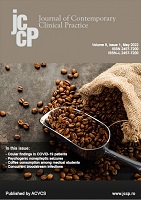A monomicrobial S. epidermidis bacteremia masked a B. pseudomallei bacteremia in a healthy female
A monomicrobial S. epidermidis bacteremia masked a B. pseudomallei bacteremia in a healthy female
Author(s): Jayaweera Arachchige Asela Sampath Jayaweera, Mahen KothalawalaSubject(s): Health and medicine and law, Demography and human biology
Published by: Asociația pentru Creșterea Vizibilității Cercetării Științifice (ACVCS)
Keywords: Melioidosis; Staphylococcus epidermidis; concurrent bacteremia; immunocompetent; clinical vigilance;
Summary/Abstract: Herein, concurrent true bacteremia with S. epidermidis and B. pseudomallei was managed appropriately in a healthy woman. A thirty-two-year-old previously well farmer presented with a 2-day history of fever and malaise. Having low blood pressure (90/60 mmHg) with a high pulse rate (104 beats/minute) she was admitted to the intensive care unit suspecting sepsis. Two blood cultures from 2 different venipuncture sites were collected and empiric intravenous (i.v.) ceftriaxone was commenced. On day 2, C-reactive protein (CRP) was 320 mg/dL and procalcitonin (PCT) was 128 ng/dL and both cultures yielded methicillin resistant S. epidermidis (MESE), subsequently, vancomycin was added. On day 5, she developed breakthrough fever despite adequate therapy. The CRP level decreased to 110 mg/dL, however, PCT rose to 148 ng/dL. Subsequently, meropenem was added replacing ceftriaxone. Two sets of repeated blood cultures yielded MRSE and MRSE with B. pseudomallei, respectively. B. pseudomallei-IgM antibody titer was 1:5600 (cut off 1:320). Oral cotrimoxazole was added. On day 7, CRP and PCT decreased to 140 mg/dL and 67 ng/dL, and by day 9 only B. pseudomallei was isolated. Vancomycin was continued for a total of 10 days. Following 21 days of meropenem, the patient was discharged with oral cotrimoxazole for 90 days. Concurrent bloodstream infection with S. epidermidis and B. pseudomallei is rare and not documented in the literature. Clinical vigilance has provided an opportunity to detect the pathogens in advance and proceed to a complete cure.
Journal: Journal of Contemporary Clinical Practice
- Issue Year: 8/2022
- Issue No: 1
- Page Range: 25-29
- Page Count: 5
- Language: English

